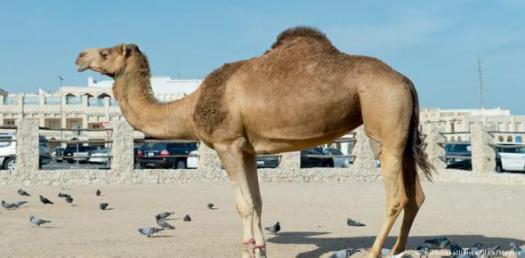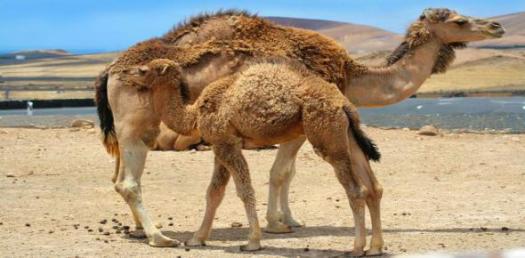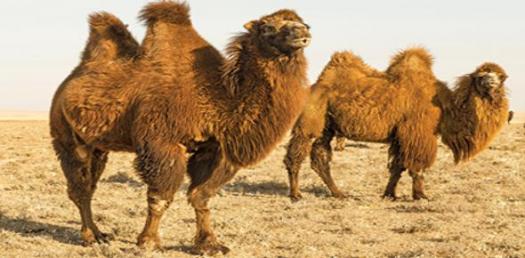How Much Do You Know About Camel Animal? Quiz!

Camels are large animals that have a prominent hump(s) on their back. They are often domesticated for labor, as a source of food and textile. Given their large size and nature, they are used in the transportation of goods and humans in the less civilized world. Camels are strong and sociable. Have you seen one?
- 1.
How many sets of eyelids do feral camels have?
- A.
Three sets
- B.
Three sets
- C.
Four sets
- D.
Two sets
Correct Answer
D. Two setsExplanation
Feral camels have two sets of eyelids. The first set is a thin, transparent membrane that acts as a protective barrier for their eyes. The second set is a thicker, more opaque eyelid that can be closed to shield their eyes from harsh desert conditions such as sandstorms. Having two sets of eyelids helps feral camels to adapt and survive in their natural environment.Rate this question:
-
- 2.
How long does it take a pregnant camel to produce a calf?
- A.
13 months
- B.
14 months
- C.
8 months
- D.
11 months
Correct Answer
B. 14 monthsExplanation
The correct answer is 14 months. Camels have a gestation period of approximately 14 months, which is longer than most other mammals. This extended period is necessary for the proper development of the calf before birth.Rate this question:
-
- 3.
When do camel wrestling events hold on Turkey?
- A.
January
- B.
April
- C.
September
- D.
February
Correct Answer
A. JanuaryExplanation
Camel wrestling events are held in Turkey during the month of January. This traditional sport involves male camels competing against each other in a wrestling match, where they try to push their opponent down. It is a popular event in Turkey and attracts both locals and tourists. The specific timing of these events in January allows people to witness and enjoy this unique cultural experience.Rate this question:
-
- 4.
Where is the U.S Camel Corps situated?
- A.
Louisana
- B.
California
- C.
Texas
- D.
Washington
Correct Answer
B. CaliforniaExplanation
The U.S Camel Corps is situated in California.Rate this question:
-
- 5.
When was French Camel Corps created?
- A.
1912
- B.
1918
- C.
1918
- D.
1913
Correct Answer
A. 1912Explanation
The French Camel Corps was created in 1912.Rate this question:
-
- 6.
When was the Imperial Camel Corps created?
- A.
1918
- B.
1916
- C.
1923
- D.
1927
Correct Answer
B. 1916Explanation
The correct answer is 1916. The Imperial Camel Corps was created in 1916 during World War I. It was a British military unit that was formed to fight in the Middle Eastern theater of the war. The corps was made up of soldiers from Britain, Australia, New Zealand, and India, and they used camels for transportation in the desert. The Imperial Camel Corps played a significant role in the campaigns against the Ottoman Empire in the Sinai Peninsula and Palestine.Rate this question:
-
- 7.
What is the maximum speed camels can run at?
- A.
55 mph
- B.
45 mph
- C.
65 mph
- D.
70 mph
Correct Answer
C. 65 mphExplanation
Camels can run at a maximum speed of 65 mph. Camels are known for their ability to travel long distances in the desert, and they have adapted to withstand extreme temperatures and harsh conditions. Their long legs and strong muscles enable them to reach impressive speeds, making them one of the fastest land animals. However, it is important to note that this is their maximum speed and they may not sustain it for long periods of time.Rate this question:
-
- 8.
Which of these classes of animals do camels belong?
- A.
Omnivores
- B.
Carnivores
- C.
Herbivores
- D.
Scavengers
Correct Answer
C. HerbivoresExplanation
Camels belong to the class of animals known as herbivores because they primarily feed on plant material such as grasses, leaves, and desert vegetation. They have adapted to survive in arid environments by consuming these types of food and can go for long periods without water. Their digestive system is specially designed to extract maximum nutrients from the plants they eat, allowing them to thrive in desert regions where other animals may struggle to find food.Rate this question:
-
- 9.
Which of these is done by camels when threatened?
- A.
Running
- B.
Kicking
- C.
Spitting
- D.
Chewing
Correct Answer
C. SpittingExplanation
Camels have the unique ability to spit when they feel threatened. They use this defense mechanism to protect themselves from potential predators or intruders. By spitting, camels can accurately aim at their target and release a mixture of saliva and stomach contents, which can be foul-smelling and even acidic. This behavior serves as a warning signal to deter any potential threats and keep them at a safe distance.Rate this question:
-
- 10.
Which of these class of animals are camels?
- A.
Reptiles
- B.
Ruminants animals
- C.
Non-ruminants animals
- D.
Primates
Correct Answer
C. Non-ruminants animalsExplanation
Camels are classified as non-ruminant animals. Ruminant animals have a four-chambered stomach and chew cud, while non-ruminant animals have a single-chambered stomach and do not chew cud. Camels belong to the family Camelidae and have a single-chambered stomach, making them non-ruminant animals.Rate this question:
-
Quiz Review Timeline +
Our quizzes are rigorously reviewed, monitored and continuously updated by our expert board to maintain accuracy, relevance, and timeliness.
-
Current Version
-
Mar 21, 2023Quiz Edited by
ProProfs Editorial Team -
Feb 28, 2019Quiz Created by
Gregorynaomi
- Amphibian Quizzes
- Bird Quizzes
- Cat Quizzes
- Dinosaur Quizzes
- Dog Quizzes
- Emperor Penguin Quizzes
- Endangered Species Quizzes
- Fish Quizzes
- Goat Quizzes
- Hamster Quizzes
- Horse Quizzes
- Insect Quizzes
- Invertebrate Quizzes
- Mammal Quizzes
- Mouse Quizzes
- Nematode Quizzes
- Pet Quizzes
- Pig Quizzes
- Rabbit Quizzes
- Reptile Quizzes
- Sheep Quizzes
- Wolf Quizzes
- Zoo Quizzes
 Back to top
Back to top












